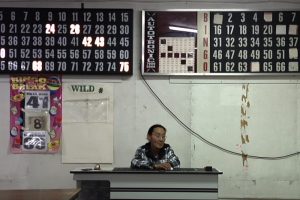Island on the Edge: Gina Abatemarco’s Kivalina

The Independent's Courtney Sheehan catches up with Abatemarco at Berlinale and discusses the relationships involved in documentary filmmaking
Kivalina is an Alaskan island 80 miles north of the Arctic circle. A community of Inupiaq Eskimos have called the island home for centuries, but today climate change threatens Kivalina’s future. Kivalina, Gina Abatemarco’s documentary feature debut, tells stories about the island, its people and their way of life. It premiered in the 66th Berlinale in a special section on Culinary Cinema.
Berlinale’s choice to present the documentary in a section focused on food rather than the environment is clearly tied to the central role that food plays in the lives of the people in Kivalina. Much of the film’s focus is on hunting and preparing food distinctive to the Arctic climate and culture: seal, whale, walrus, caribou. Abatemarco was initially moved to follow the story when she read a 2007 article in The Los Angeles Times that depicted Kivalina as an island under threat of destruction by climate change. Abatemarco was struck by the subtext of cultural loss. “Here was this place where people had lived a certain way for generations,” Abatemarco said. “That people would have to tell their children, ‘we will not be able to go on the way we promised you.’ I have a writing background so the idea of having to let down a generation, and the devastation of the generation that has to do, it was really interesting to me.” A couple months earlier, she had picked up a book of photography by Fred Bruemmer called The Arctic World that had left a lasting impression with its “palate of images of what the north could be.” The seeds for Kivalina were sown.
The film was first developed as a short through the Berlinale Talent Campus in 2008. Abatemarco applied for a Berlin Today Award to make a film celebrating the fall of the Berlin Wall. She proposed a short film about Kivalina’s first seawall, “which was a pile of sandbags on their broken coastline.” She won the 30,000 euros grant and the resulting short, My Super Sea Wall, formed the basis for the feature. Cinematographer Zoe White also participated in the Talent Campus and worked with Abatemarco to take the film to the next step and turn it into a feature.
Kivalina was funded through a variety of sources, including Vision Maker Media, which will entail a 2017 premiere on public television, though “who’s going to air it is still in negotiation.” Abatemarco also received funding and support from the Tribeca Film Institute and IFP Labs. “I don’t think I would have finished the film if I hadn’t been with IFP Film Labs. That community and the IFP have been wildly nurturing and really pushes you to close,” Abatemarco said. Funding was rounded out by a Richard Vague/Chris Columbus award from New York University, a grant from the Puffin Foundation, a private donor, and a Kickstarter. “A low budget labor of love,” sums up the director.
The quiet, vérité style documentary captures family activities and community rituals like the preparation of caribou meat, a teen dance night in the community center, church services, and public meetings with representatives of the American government and military. While watching the film with an audience for the first time in Berlin, Abatemarco realized that the film was, “also a portrait of myself as an American exploring the really terrible decisions the United States has made for its indigenous people, starting way back. This film is an exploration of the fallout of government decisions. It’s strange that the film took a different shape when I showed it abroad. You realize that you’re not documenting the other culture, you’re documenting your culture.”

Abatemarco, who spent nearly seven years making Kivalina, advises first-time documentarians to recognize that some of the hardest work of making a film is not technical or financial, but interpersonal. “It’s about your relationship with your subjects over time. That is the real work and the real difficulty. Somehow you’ll find the money but the most difficult work is to carry the story for however long you have to carry it, because these are heavy subject matters.” When it came to familiarizing herself with Inupiaq culture and history, Abatemarco remarks, “I really over the years became educated, schooled, and devastated as I got deeper into the story.”
Abatemarco’s distribution plan combines a variety of types of screenings, territories and platforms. Given the 64 minute runtime, she hopes it will be a viable product for international television broadcasters. “I see my theatrical distribution as festivals, institutional screenings like museums and universities, and then a Capitol Hill screening, which will bring Kivalina to Washington. Nobody takes the time to spend some time in Kivalina so this will be an important screening. And then the goal is to go back to Alaska and screen in Arctic villages,” as well at institutions in a number of Arctic countries.
